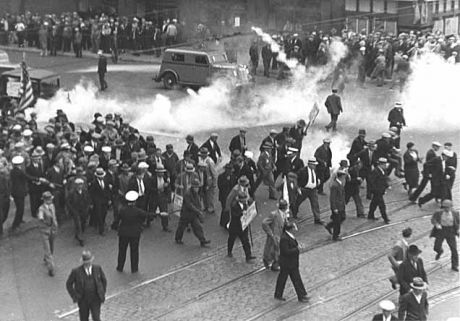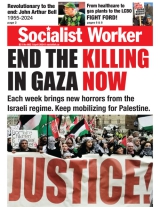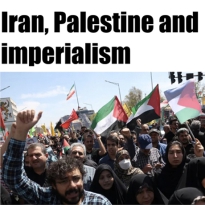Features
You are here
Remembering the 1934 Teamsters rebellion

December 11, 2012
In 1934, the American economy was in a deep recession. While the 30s in the US are remembered as a decade of labour struggle, states around the country varied in levels of worker militancy and organization.
Minneapolis was what one could call an "open shop,” a town with few unions and few unionized workers. It was a town with horrid working conditions, and a gap between rich and poor that would leave you breathless. Virtually every major attempt to unionize an industry had been broken by the local employers group, the Citizens Alliance. What unions were there often consisted of conservative leaders adverse to strike action.
This brings us to the case of the International Brotherhood of Teamsters (Teamsters being a slang term used to refer to members of the truck-driving industry). This umbrella union (organizing across industry lines) was small, with no more than 75 members.
Radicals
Teamster Local 574, in contrast to the conservative leadership of the union, counted several card-carrying militants of the Communist League of America (the American section of Trotsky's International Left Opposition) among those 75 rank-and-file members. These militants, including Ray Dunne, Carl Skoglund, and later Farrell Dobbs (who in 1972 published the biography of the strike Teamster Rebellion), had for several years tried to organize one large unionized force representing all drivers regardless of industry.
Teamster members, because they so often came into contact with workers in other unionized industries, were often called on to support other union strikes, and, despite their small numbers, had developed strong solidarity with several other industrial areas.
In February 1934, this solidarity was put on full display when a strike was called in the Minneapolis coal yards with the aim of gaining union recognition from the companies that owned the yards. As mentioned previously, union recognition for workers was a hard thing to achieve in Minneapolis, thus organization was key.
On February 7th, 65 of the 67 yards were closed by workers, and a Voluntary Organizing committee was set up by the aforementioned Local 574 members Dunne, Skoglund, and Dobbs. The committee played a large role in organizing strike activities, as well as organizing workers after the strike. Owing to the especially cold winter of 1934, and the substantial demand for coal, the employers admitted defeat after three days of blockades and strike action, and officially recognized a coal yard union.
The victory for the coal workers gave Local 574 and other unions a huge boost in confidence, and inspired workers to join unions en masse, with Teamster numbers growing to 3,000 by April.
Growth
By May, organized driver numbers had grown to 5,000, and a general drivers strike was being conceived, due in part to the city’s failure to recognise the Teamsters union and Local 574 (other demands included increased wages, shorter hours and the right to represent “inside” workers, such as warehouse and loading bay workers). Preparations for the strike included renting a hall to be used as a base-of-operations and infirmary, discussions with sympathetic organizations of farmers to obtain their support for the coming strike, and laying the foundation for the first American daily strike newspaper, The Organizer, which would detail the unions struggle and demands, and give reports on the strikes progress.
On May 16, the strike was officially called. Despite Teamster national leadership opposition, the strike was incredibly successful, shutting down nearly all the commercial trucking in the city. Flying pickets (highly mobile groups of picketers) roamed the city’s streets, and daily demonstrations occurred in front of city hall in support of the strikers. The support of the Minneapolis unemployed helped to disable employers’ attempts to use scab drivers.
Police brutality
On May 19, the first major occurrence of police brutality against the strikers came to a head. Strikers attempting to stop scabs from unloading a truck at the local market were assaulted by police and Citizens Allience-hired private guards, and driven back. Those strikers who were injured during the assault were followed by police back to the strike headquarters, who, upon arrival, were not only barred from the command post, but two of the officers were left unconscious on the sidewalk outside.
A second wave of battles occurred on May 21, when employers and several hundred police deputies attempted to fully open the market. About 600 workers armed with clubs arrived and a large battle ensued. Over 30 police officers were hospitalized, but no strikers were arrested, though some were badly injured. Fighting intensified the next day, May 22, when 20,000 strikers, sympathizers and spectators gathered in the central market area. Despite police advances, the strikers quickly gained the upper hand, and successfully drove out the police and Citizens Alliance private guards, ultimately leaving two deputies dead, one of whom who was a member of the board of directors of the Citizens Alliance. Still, no picketers were arrested.
By the time of the May 22 market battle between strikers and police, approximately 35,000 workers in industries as varied as dock, building and freight had taken the initiative and walked out in solidarity with the Teamsters and to protest police violence. The local AFL (American Federation of Labour) council organized financial support and convinced other industries to join the strike.
Despite the smear campaign being perpetrated by the local media (with headlines of “COMMUNIST STRIKE” printed on newspapers across the city), pitched battles between strikers and police and the threat of the National Guard descending upon the town to “discipline strikers and teach a lesson to potential troublemakers”, strikers stayed strong, and on May 25 the employers reached a settlement with labour organizers that agreed to union demands, including union recognition, representation of inside workers and the reinstating of sacked union members and strikers.
In the following weeks, it became clear though that the employers of the city had no intention of holding up their end of the bargain, thus on June 17 the city’s workers returned to striking with renewed vigour, this time though with a different style, as union leadership ordered strikers to picket whilst not armed. Again, the trucking industry all but stopped, along with several other industries around the city.
Tragedy
On Friday, June 20, a large group of unarmed strikers were lured (reportedly by police deputies in a scab truck) to the city’s market. Upon arrival, 100 policemen armed with shotguns opened fire on the group. Many of the strikers turned to run, only to be struck in the back by gunfire. By the time the animosity ended, an estimated 65 were injured, and two strikers, John Belor and Henry Ness, were murdered. Christened “Black Friday”, the violence left the city and nation in shock. A reported 100,000 people attended the funerals, and the following press release was issued in the striker’s paper: “Police took direct aim at the pickets and fired to kill. Physical safety of the police was at no time endangered. No weapons were in possession of the pickets."
Both sides took collective steps back from the confrontation after the funeral for varying reasons, but with even higher levels of support from other unions than before, the strike continued. Six days after, on July 26, Governor Floyd. B Olson deployed 4,000 members of the National Guard and enforced martial law upon Minneapolis, outlawing picketing. The union’s involved, seeing this as a chance to achieve triumph once-and-for-all, vowed to return to the streets on August 1, but never got the chance, as that night, July 31, strike headquarters was surrounded and raided by National Guardsmen, and union leaders were arrested and placed in the nearby stockade. Despite the attempt by the state to end the strike, the rank-and-file workers were able to remain in control, and the next day 40,000 people marched on the stockade, calling for the release of the union leaders. Under this immense pressure, the union leaders were released and headquarters was restored. Although weakened by martial law, the workers made it clear that the strike would continue.
Victory
The strike continued for several more weeks, and on August 21, the 101-day strike came officially to an end. The Citizens Alliance, broken by the strike, accepted the union’s major demands. Workplace elections were held for industries with members who struck to decide if the socialist-led Local 574 would represent their workplace, to which the overwhelming-majority said yes. Mass organizing and unionization occurred across the state of Minnesota, and a writer for the Minneapolis Labour Review later summed the event up with the following: “The winning of this strike marks the greatest victory in the annals of the local trade union movement...it has changed Minneapolis from being known as a scab’s paradise to being a city of hope for those who toil".
Today’s rank-and-file workers, and Left in general, can learn a great deal from this and other worker conflicts of the 1930s. With solidarity between workers being the key to victory in this episode, it is necessary above all to remember that we are all human, and regardless of work, industry, race, sex or age, we must all join together in the fight for the better world that is hidden behind the dark cloud of Capitalism.
Section:
- Log in to post comments










